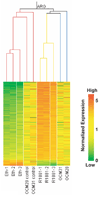Osteoblast-derived factors induce an expression signature that identifies prostate cancer metastasis and hormonal progression
- PMID: 19351846
- PMCID: PMC5794011
- DOI: 10.1158/0008-5472.CAN-08-3506
Osteoblast-derived factors induce an expression signature that identifies prostate cancer metastasis and hormonal progression
Abstract
Identification of gene expression signatures associated with metastases provides a tool to discern mechanisms and potential therapeutic targets and may lead toward a molecular classification system in pathology. Prostate cancer (CaP) frequently metastasizes to the bone to form osteoblastic lesions. Correlative clinical data and in vitro evidence have led to the hypothesis that osteoblast-derived factors promote hormonal progression of CaP cells. Here, the gene expression signature of CaP exposed to osteoblast-derived factors was identified. This signature included known androgen-regulated genes, oncogenes, tumor suppressors, and genes whose products are involved in apoptosis and cell cycle. A comparative functional genomic approach involved the application of this responsive gene expression signature to clinical samples of human CaP, melanomas, and oral cancers. Cluster analysis revealed that this gene expression signature had specificity for CaP and could resolve clinical specimens according to stage (benign, localized, and metastatic) and androgen sensitivity with an accuracy of 100% and 80%, respectively. Together, these results suggest that factors derived from osteoblasts induce a more advanced phenotype of CaP and promotes hormonal progression.
Figures






References
-
- Cheville JC, Tindall D, Boelter C, et al. Metastatic prostate carcinoma to bone: clinical and pathologic features associated with cancer-specific survival. Cancer. 2002;95:1028–1036. - PubMed
-
- Wang G, Sadar MD. Amino-terminus domain of the androgen receptor as a molecular target to prevent the hormonal progression of prostate cancer. J Cell Biochem. 2006;98:36–53. - PubMed
-
- Blaszczyk N, Masri BA, Mawji NR, et al. Osteoblast-derived factors induce androgen-independent proliferation and expression of prostate-specific antigen in human prostate cancer cells. Clin Cancer Res. 2004;10:1860–1869. - PubMed
-
- Gleave M, Hsieh JT, Gao CA, von Eschenbach AC, Chung LW. Acceleration of human prostate cancer growth in vivo by factors produced by prostate and bone fibroblasts. Cancer Res. 1991;51:3753–3761. - PubMed
-
- Rickard DJ, Kassem M, Hefferan TE, Sarkar G, Spelsberg TC, Riggs BL. Isolation and characterization of osteoblast precursor cells from human bone marrow. J Bone Miner Res. 1996;11:312–324. - PubMed
Publication types
MeSH terms
Substances
Grants and funding
LinkOut - more resources
Full Text Sources
Other Literature Sources
Medical
Miscellaneous

